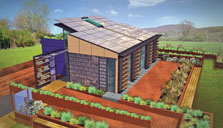

One of many "materials of opportunity" used by the Penn State team is lumber from a white oak tree that had fallen naturally. Students used the lumber to create a set of movable sun shades on the south wall of their house.
Download Construction Drawings
(Zip 61 MB)
Neither the United States, nor the Department of Energy, nor the Alliance for Sustainable Energy LLC, nor any of their contractors, subcontractors, or their employees make any warranty, express or implied, or assume any legal liability or responsibility for the accuracy, completeness, or usefulness for any purpose of any technical resources or data attached or otherwise presented here as reference material.
Solar Decathlon 2007
Penn State
Embracing the Possibilities
When abundant opportunities and possibilities are on the horizon, people often get stuck deciding which ones to pursue. Not so for the Penn State Decathlon team. This high-energy group of students is taking them on one after another.
The Penn State students were inspired by the challenge of the Decathlon's Market Viability contest and decided to build two homes to test themselves and their market concept. The competition home is called MorningStar Pennsylvania. After the Decathlon, it will serve as a renewable energy research lab and educational residence on the Penn State campus. Its sister home, MorningStar Montana, will house visiting faculty at Chief Dull Knife College on the Northern Cheyenne Reservation. This affordable version of the MorningStar concept will help advance the use of solar energy in another climate and culture.
"We see our Solar Decathlon home, and the one in Montana, as prototypes where people can learn," says member Sal Gimbert. The team used a hybrid construction process with a mix of prefab and site-built elements. The "Technical Core" of the house (kitchen, bath, mechanical components) is shipped to the home's location, and locally available "materials of opportunity" are used to complete the home.
An "Energy Dashboard" monitors and displays energy consumption and production to teach the inhabitants about how they are "spending" their energy. A curtain wall system with PV-powered LED lighting glows in different colors depending on weather forecasts. Pennsylvania bluestone and reclaimed slate shingles provide thermal mass.
The students saw the talent and expertise available at Penn State as yet another opportunity. "From the beginning, we wanted to engage as many university programs as possible. So, we kept the design process open to a range of disciplines throughout the university. Close to 900 Penn State students have been involved in the Solar Decathlon," says member Andreas Phelps.
"We want to be outstanding representatives for the Penn State community by using the Solar Decathlon as a catalyst to reach our long-term goals," says member Gretchen Miller. "There's no stopping us."
Team Contact
David R. Riley
driley@engr.psu.edu
